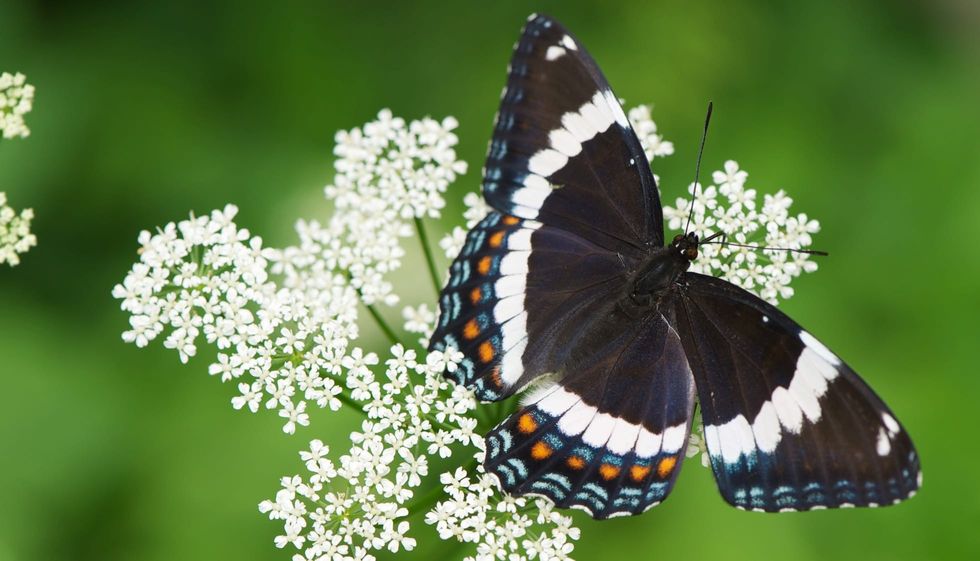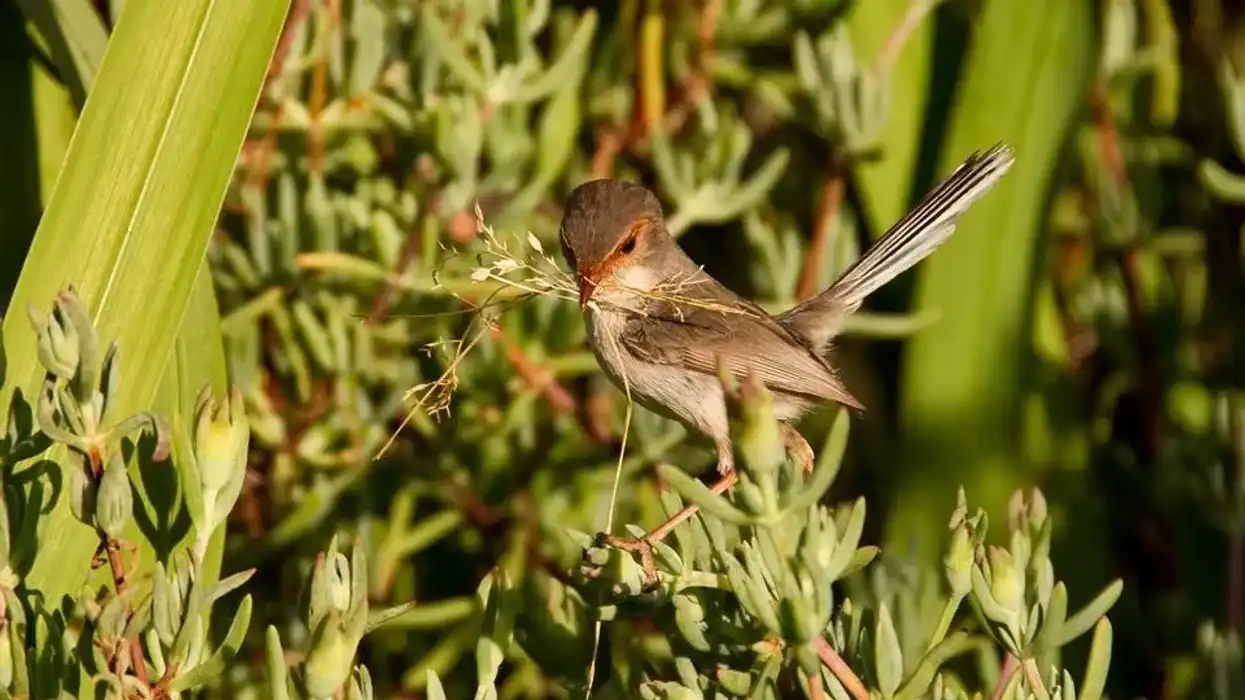The white admiral butterfly is a species of butterfly endemic to the continent of North America, mainly the countries of America and Canada. The white admiral butterfly lives in woodlands mainly and also on forest edges and even roadsides.
The white admiral is synonymous with the red-spotted purple or the red-spotted admiral butterfly and they are collectively referred to as the Limenitis arthemis species. These two subspecies however are known to indulge in one of nature's most significant hybridization processes.
White admirals are mostly seen in the Rocky Mountains, New England, and Great Lakes regions.
The red-spotted purple butterflies are capable of mimicking the pipevine swallowtail butterflies, which are unpalatable to predators. The females of the white admiral species are slightly bigger than the males.
The white admiral butterflies are known to indulge in territorial fighting which involves jostling and aerial maneuvers, which are quite spectacular. The white admiral is Not Evaluated by the IUCN but is considered a 'Secure' species by NatureServe.
For more relatable content, check out these luna moth facts and hag moth facts for kids.
White Admiral Interesting Facts
What type of animal is a white admiral?
The white admiral (Limenitis arthemis) is a butterfly.
What class of animal does a white admiral belong to?
The white admiral belongs to the Insecta class of animals.
How many white admirals are there in the world?
It is unclear how many white admirals are there in the world since an adult white admiral's life lasts only for close to four months.
Where does a white admiral live?
White admiral butterflies are widespread over the North American continent in the countries of America mainly, but also Canada. The Rocky Mountains, New England, and the Great Lakes form the American range of white admirals.
What is a white admiral's habitat?
The white admiral likes to inhabit deciduous woodlands, forest edges, roadsides, clearings, and mixed evergreen forests. They are often seen on their food resource plants.
Who do white admirals live with?
Being butterflies, white admirals are solitary creatures. It is rare to see multiple white admirals together since they can be very territorial as well.
How long does a white admiral live?
After emerging from the egg one week after it is laid, the white admiral butterfly exists in the caterpillar stage for about two weeks, and in the pupal stage for 10-14 days. The adult white admiral butterfly lives for four months only.
How do they reproduce?
White admirals reproduce by mating and laying eggs that go through the life cycle stages of egg, caterpillar, pupa, and adult. The males are very territorial and perch on foliage instead of host food trees which is ironic.
Males are known to compete fiercely for territory and hence for females, indulging in fighting, jostling, and aerial maneuvers. A mating female shall land on a leaf with the male following her if she closes the dorsal wings, it implies she does not want to mate with this particular male.
After mating, eggs are laid on host trees which hatch into caterpillars after seven days, followed by the pupal stage and finally becoming an adult.
The white admiral is synonymous with the Limenitis arthemis species, but it also consists of the red-spotted purple butterfly or red-spotted admiral butterfly. This is because these are two distinct yet similar species that mate to form hybrid butterflies. The hybridization occurs in Southern Ontario, New England, and the Great Lakes region.
What is their conservation status?
The conservation status of white admiral butterflies according to NatureServe is 'Secure' while IUCN has them under Not Evaluated.
White Admiral Fun Facts
What do white admirals look like?
There are two major groups of the white admiral butterfly species, the white admiral (Limenitis arthemis arthemis) and the red-spotted admiral (Limenitis arthemis astyanax). The wings of the L. a. arthemis butterfly have a bright white band whereas the L. a. astyanax 's wings do not have this white band, but have shades that are a cooler blue-green instead.
The uppersides of the L. a. arthermis subspecies are blackish-blue. Some of the admirals have submarginal spots that are red, some have blue spots. The wings' undersides are blackish and have post-median white bands too. The basal area has red spots too. The marginal and submarginal areas are seldom reddish-brown.
The hindwings of the L. a. astyanax subspecies are iridescent bluish-green or iridescent blue. The basal area has red spots and there are also submarginal spots that can be red or bluish.
The females of the white admiral species are bigger than the males.

How cute are they?
The white admiral butterflies are absolutely adorable and stunningly beautiful animals. The white admiral appearance is mostly bluish-black and they sometimes appear electric blue.
They may or may not have bright white bands on their wings but that doesn't take anything away from their majestic beauty. They have more colors in the form of red spots. White admiral butterflies are almost constantly in motion and are known to indulge in spectacular aerial displays while claiming territory.
How do they communicate?
Being butterflies, white admirals communicate via chemical pheromones and physical actions. The males compete against one another by jostling and aerial maneuvers. The females relay their intention to not mate by closing their dorsal wings. The L. a. astyanax subspecies is able to mimic the pipevine swallowtail butterfly when predators are close by because it is not palatable.
How big is a white admiral?
The white admiral butterfly has a wingspan of 2.4-2.8 in (6-7 cm), which makes it about the same size as the purple emperor butterfly. The white admiral size is nearly three times smaller than the morpho butterfly.
How fast can white admirals fly?
Like most other butterflies, white admirals may move at speeds of 5-12 mph (8-19.3 kph).
How much does a white admiral weigh?
The white admiral has a negligible weight of 0.02 oz (0.5 g).
What are the male and female names of the species?
The males and females of the white admiral species do not have specific names.
What would you call a baby white admiral?
A baby white admiral could be called a caterpillar, a larva, or a pupa before it becomes an adult.
What do they eat?
White admiral butterflies feed on rotting fruit, nectar, aspen, willow, poplar, birch, wild cherry, black oaks. They themselves get preyed on by birds, lizards, spiders, frogs, and toads.
Are they dangerous?
No, white admiral butterflies are not dangerous at all.
Would they make a good pet?
White admiral butterflies are wild insects that thrive in their chosen woodland habitats. They should not be attempted to be taken as pets.
Did you know...
The white admiral (Limenitis arthemis arthemis) butterfly is the insect emblem for the Canadian province of Quebec. It also happens to be the official butterfly of the American state of New York.
White admiral caterpillars
Caterpillars of the white admiral species feed on aspen, willow, poplar, black cherry, and yellow birch trees. In the breeding season, two broods are had by white admirals. The caterpillars from the first brood grow halfway and then hibernate till spring starts, which is when they emerge.
The caterpillars from the second brood sometimes die because they are unable to mature when hibernation begins. The larvae after hatching have yellow borders and brown bodies and heads. They mature into an olive-brown color with red-brown legs and prolegs.
White admiral butterfly host plant
Host plants in the white admiral range include birches, willows, hawthorns, shadbush, apples, bird-cherry, black cherry, poplars, aspens, ironwood, water elm, and the North American beech.
Here at Kidadl, we have carefully created lots of interesting family-friendly animal facts for everyone to discover! Learn more about some other arthropods from our puss moth interesting facts and gypsy moth surprising facts pages.
You can even occupy yourself at home by coloring in one of our White Admiral Butterfly coloring pages.









